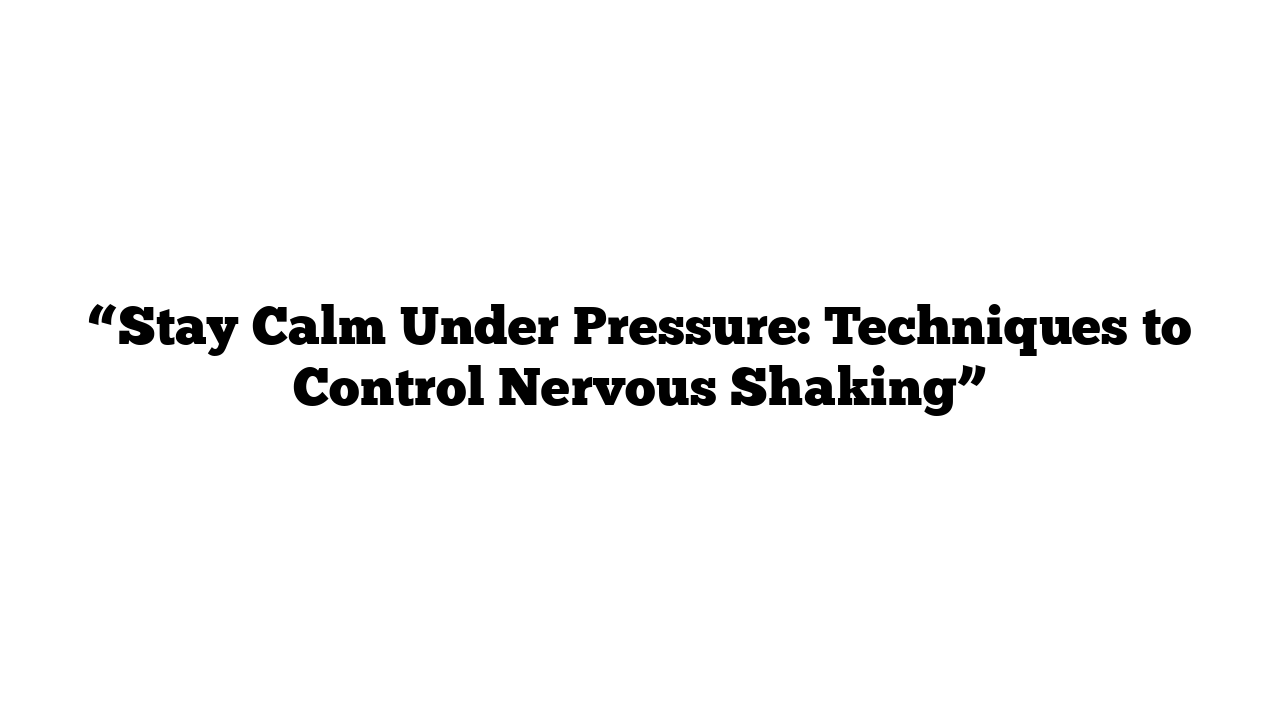How to Stop Shaking When You’re Nervous: Understanding and Managing Adrenaline
Public speaking, meeting someone new, or performing under pressure can make your hands tremble and heart race. If this sounds familiar, you’re not alone! This common experience is often due to a natural response from your body: adrenaline. Let’s dive into what adrenaline is, why it causes physical reactions like shaking, and—most importantly—how you can manage these symptoms effectively.
What is Adrenaline?
Adrenaline, also known as epinephrine, is a hormone produced by your adrenal glands in response to stress or excitement. It’s the body’s natural way of preparing for action when faced with a “stressor.” Stressors can be anything that challenges or excites you—public speaking, sports, skydiving, or even meeting someone you like.
When adrenaline is released, it increases blood flow, boosts breathing, and quickens metabolism to prepare your body for intense physical activity. While these effects were historically useful in life-or-death situations, in modern times, adrenaline can still take over even if you’re just giving a speech or taking a test. This rush can leave your body in “overdrive,” sometimes causing shaking, sweating, and even a pounding heartbeat.
How Adrenaline Affects the Body
- Muscle Shaking: When adrenaline is released, it prepares your muscles to react. This is why you might feel shaky—your muscles are primed and ready to move even if there’s no need.
- Increased Heart Rate and Blood Flow: Ever feel your heart pounding when nervous? That’s adrenaline pushing more blood to your muscles, preparing you for “fight or flight.”
- Enhanced Strength: This surge of energy has even been linked to rare instances of “hysterical strength,” where people display extraordinary feats, such as lifting heavy objects during emergencies. The science behind this isn’t fully understood, but it shows the powerful impact of adrenaline.
“Adrenaline enables us to react quickly, often without conscious thought, allowing our bodies to respond with strength and energy when we need it most,” explains Dr. Sarah Thompson, MD.
Why We React to Adrenaline
The hypothalamus—a small but vital area in your brain—controls this adrenaline release. Responsible for maintaining homeostasis (the body’s internal balance), the hypothalamus helps regulate stress, hunger, thirst, and more. When we encounter stress, our hypothalamus triggers adrenaline, preparing us to act.
Interestingly, different people experience adrenaline in unique ways. Some may feel shaky or jittery, while others might become teary-eyed. Crying, for instance, actually helps release stress hormones, while yelling activates the amygdala (the brain’s fear center), releasing chemicals that help you feel better.
Combatting the Effects of Adrenaline with Breathing
One of the most effective tools for managing adrenaline is controlled breathing. This technique is widely used by professionals in high-stress roles—such as police officers, military personnel, and athletes—to manage their body’s stress response. Let’s take a closer look.
Tactical Breathing Technique
To use controlled breathing (also known as “tactical” or “combat” breathing), try the following steps:
- Inhale slowly for a count of four.
- Hold your breath for a count of four.
- Exhale for a count of four.
This method helps activate your parasympathetic nervous system, which counteracts the “fight-or-flight” response. By focusing on slow, deep breaths, you stimulate the vagus nerve (the 10th cranial nerve connecting your brain to your torso), which helps lower heart rate, reduce blood pressure, and bring your body back to a calm state.
Over time, with regular practice, controlled breathing can help you maintain composure in stressful situations. Imagine the next time you’re nervous—you take a deep breath, calm yourself, and feel grounded rather than overwhelmed.
“Breathing isn’t just about oxygen; it’s one of the simplest ways to calm the body. When used properly, it can help us stay focused and present, even in challenging moments,” notes Dr. Thompson.
A Real-Life Example: U.S. Air Force Training
Members of the U.S. Air Force, along with other high-risk professionals, regularly train in these breathing techniques to help manage stress effectively. Imagine being in a high-stakes situation where clear thinking is essential. Controlled breathing provides these professionals with a simple tool to keep their bodies—and minds—steady.
Next time you’re about to face a challenging situation, try tactical breathing. For more insights on health and stress management, visit medicaltimes.io.
Quick Tips to Stay Calm:
- Take Deep Breaths: Use the 4-4-4 method to regain control.
- Visualize Success: Picture yourself confidently handling the situation.
- Move a Little: Sometimes, light physical activity can help release extra adrenaline.
- Shift Focus: Think about what you want to communicate rather than how you feel.
Each of these small actions can make a big difference in helping your body relax, turning a nerve-wracking moment into an opportunity for growth and success.
Related Resources:
